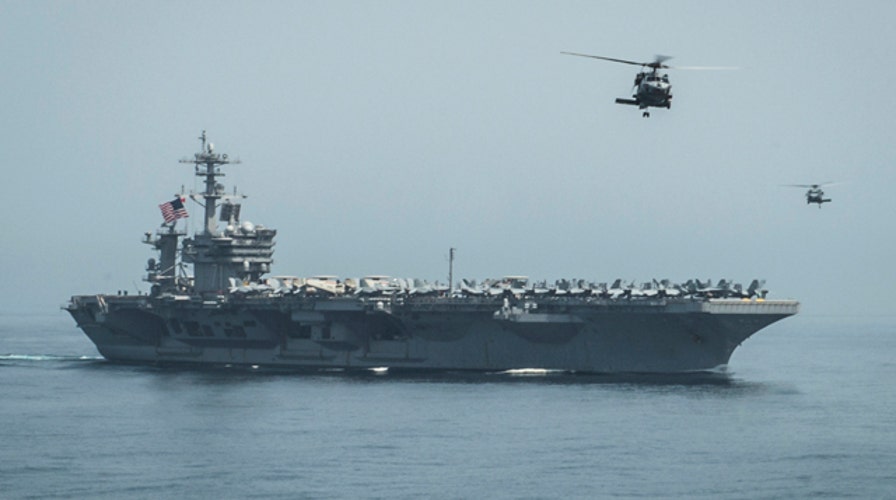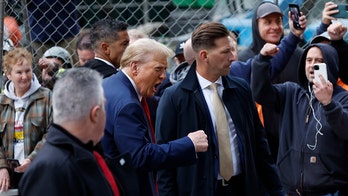Mixed messages on mission of US warship in Yemen waters
Pentagon claims blockade is there to block rebel supplies, White House claims mission is to protect trade routes
An American aircraft carrier and its warplanes are shadowing an Iranian convoy approaching Yemen, as the U.S. beefs up its presence in the region -- but back in Washington, officials can't seem to agree on why.
Pentagon sources confirmed to Fox News that the USS Theodore Roosevelt is tracking the Iranian convoy, and also launching F/A-18 Hornets to conduct "manned reconnaissance" of the estimated nine Iranian ships.
Those ships are suspected of carrying weapons to rebel fighters in Yemen.
But State Department spokeswoman Marie Harf insisted Tuesday that the U.S. ships were "only" there to "ensure the shipping lanes remain open and safe" -- and "not to do anything in terms of those Iranian ships."
She blasted "misreporting" that asserted U.S. ships were prepared to intercept Iranian vessels.
"That is blatantly untrue -- so this discreet movement of U.S. assets is for a discreet purpose," Harf said.
White House Press Secretary Josh Earnest also said Tuesday that the ships are in the region primarily to "protect the freedom of navigation and the free flow of commerce."
However, Earnest acknowledged the U.S. is very interested in tracking the movements of any potential arms deliveries to Houthi rebels.
He said "any effort by Iran or anyone else to provide weapons to the Houthis would be a clear violation" of U.N. Security Council resolutions. Earnest said the U.S. and its partners are "serious about the Iranians not providing weapons to the Houthis," and making sure the U.N. arms embargo is taken seriously.
The Pentagon also acknowledged the convoy is a factor.
Army Col. Steve Warren, a Pentagon spokesman, said the aircraft carrier is there to assure the waterways are open. But, he added, "they have moved to that area in response to the deteriorating security situation in Yemen. Many have asked me whether or not they are there because of the Iranian ship convoy or flotilla that is also in the area. That is certainly one of the factors."
The mixed messages, though, leave unclear how far the U.S. would go to enforce the embargo. The U.S. Navy generally conducts consensual boardings of ships when needed, including to combat piracy around Africa and the region. So far, however, U.S. naval personnel have not boarded any Iranian vessels since the Yemen conflict began.
A senior defense official at the Pentagon on Tuesday pushed back on reports that the White House has made a decision about boarding the suspected ships.
"The White House is not even close to making a decision," the official with close ties to the administration said.
But the movements nevertheless escalate a standoff in the waters off Yemen, which comes as the U.S. and other world powers are trying to hammer out a diplomatic deal with Iran on its nuclear program.
Navy officials first confirmed Monday that the USS Theodore Roosevelt -- along with her escort ship, the USS Normandy, a guided-missile cruiser -- had been dispatched to the Arabian Sea to help enforce a blockade of any Iranian weapons shipments to Houthi rebels in Yemen.
The Iranian convoy consists of a mix of freighters, suspected of carrying those weapons, and warships.
The convoy is about to cross over from waters off the coast of Oman to those off the coast of Yemen, in the Arabian Sea. The Iranian convoy is steaming toward an unknown port in Yemen.
The Iranian Navy ships are characterized as "smaller than destroyers," according to a Pentagon official with knowledge of the convoy. Asked what type of weapons the freighters are carrying, one Pentagon official said, "they are bigger than small arms."
The U.S. Navy has been steadily beefing up its presence in the Gulf of Aden and the southern Arabian Sea amid concerns about the Iranian convoy. There are now nine Navy warships, and three support ships, in the region.
The deployment comes after a U.N. Security Council resolution approved last week imposed an arms embargo on rebel leaders. The resolution passed in a 14-0 vote with Russia abstaining.
With the U.S. Navy's only aircraft carrier now out of the northern Persian Gulf, the Navy's contribution to the air campaign against the Islamic State also has been temporarily halted.
The U.S. Air Force has conducted 70 percent of the airstrikes against ISIS in Iraq and Syria to date. A spokesman from the U.S.-led coalition said from its headquarters in Kuwait that, "We have plenty of resources [to strike ISIS], and we are not concerned about a loss of effectiveness." But he admitted, "More is certainly better."
Fox News' Lucas Tomlinson and The Associated Press contributed to this report.





